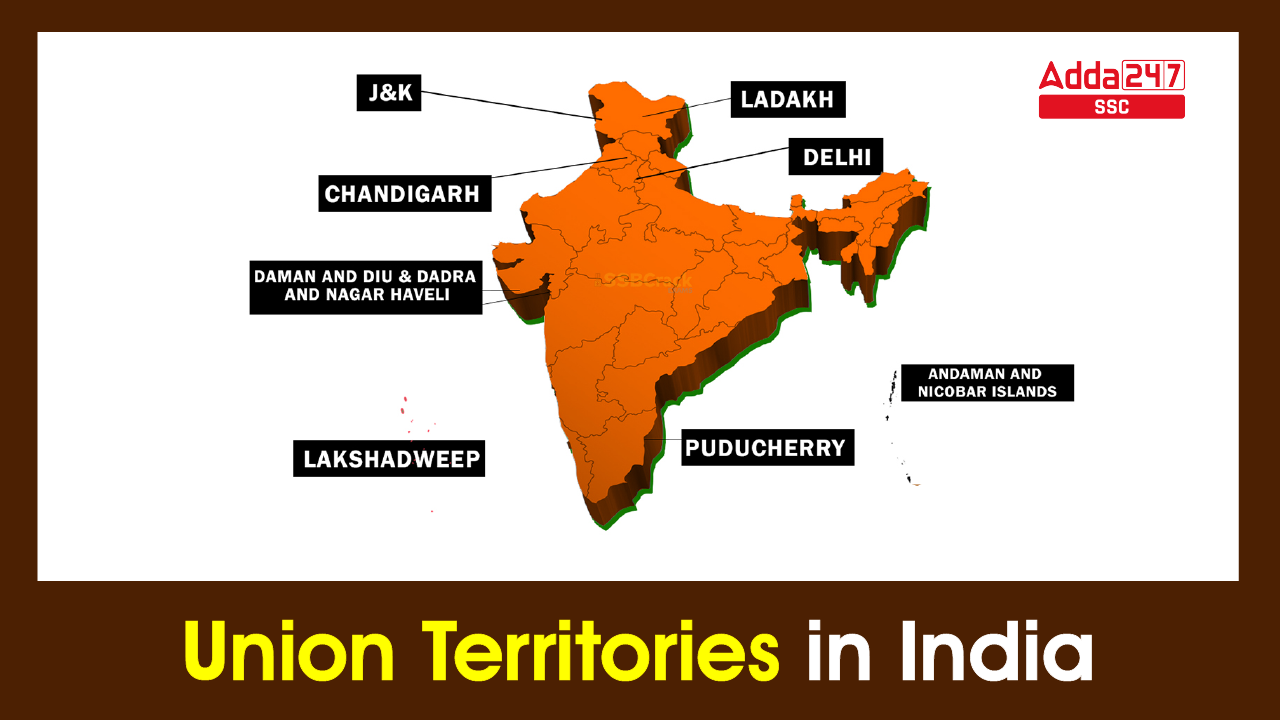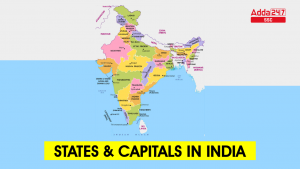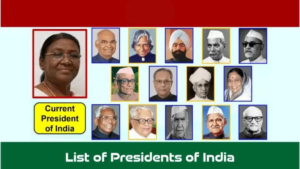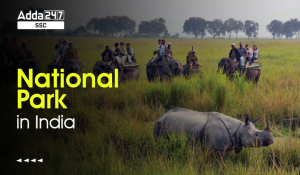Table of Contents
Union Territories in India: We all know that India is a sovereign, socialist, secular, and democratic republic country with a Parliamentary system of Government. In India, there are 28 states and 8 Union territories. According to the provisions of the constitution, during independence, the union territories were either not a part of India or were too small to be made into a state.
Union Territories in India
States Reorganisation Commission in 1956 recommended the formation of a different category for these territories & named it Union Territory. The “Union Territory” status is assigned to an Indian subdivision to protect the rights of indigenous cultures, averting political turmoil related to matters of governance, being newly inducted into India from a foreign colony, and so on.
Union Territories Formation Overview
In 1954, Puducherry was merged into the Republic of India after getting independent from French rule and became the Union Territory of Puducherry. In 1963, Puducherry was permitted the status of Partial Statehood.
In 1961, Daman and Diu, and Goa were merged into the Republic of India, after getting free from Portuguese Rule. In 1987, Goa was awarded the status of Statehood and became the first Union Territory to receive such importance. In 2020, Dadra and Nagar Haveli, and Daman and Diu were merged into a single Union Territory known as Dadra and Nagar Haveli and Daman and Diu.
In the early 1970s, Manipur, Tripura, and Himachal Pradesh were also given the status of Statehood. And Chandigarh became a Union Territory.
Delhi was primarily a State. On 27 March 1952, the first Delhi Legislative Assembly elections were held for a total of 48 seats. Chaudhary Brahm Prakash Yadav was elected the first CM of Delhi. However, after introducing the State Reorganisation Act of 1956, Delhi lost its Statehood and became a UT. In 1991, Partial Statehood status was provided to the Union Territory of Delhi and now it is known as the National Capital Territory of Delhi.
In 2019, Jammu and Kashmir Reorganisation Act, 2019 was passed by the Indian Parliament as per this act reconstituted the state of Jammu and Kashmir into two Union Territories– Jammu and Kashmir and Ladakh.
List of 8 Union Territories in India
Currently, there are 8 Union territories in India. The list of the Union Territories of India along with their capitals and founding dates is given below:
| Union territories | Capital | Founded on |
|---|---|---|
| Andaman and Nicobar Islands | Port Blair | 1 Nov. 1956 |
| Chandigarh | Chandigarh | 1 Nov. 1966 |
| Dadra and Nagar Haveli, | Daman | 26 Jan. 2020 |
| Delhi | New Delhi | 9 May. 1905 |
| Lakshadweep | Kavaratti | 1 Nov. 1956 |
| Puducherry | Pondicherry | 1 Nov. 1954 |
| Jammu and Kashmir | Srinagar (Summer) Jammu (Winter) |
31 Oct 2019 |
| Ladakh | Leh | 31 Oct 2019 |
Andaman and Nicobar Islands
Andaman and Nicobar Islands are located between 6° and 14° North Latitude and 92° and 94° East Longitude. The islands located in the north are known as the Andaman Group of Islands while the islands located in the south are called the Nicobar Group of Islands. The climate of the islands can be defined as a humid, tropical coastal climate. Andaman and Nicobar Islands receive rainfall from the southwest and northeast monsoons and the maximum precipitation is between May & December.
| Particulars | Description |
| Area | 8,249 sq. km |
| Population | 4 lakh (approx) |
| Capital | Port Blair |
| Languages | Hindi, Nicobarese, Bengali, Tamil, Malayalam, Telugu |
Dadra and Nagar Haveli and Daman and Diu
| Particulars | Description |
| Area | 491 sq km |
| Population | 4 Lakhs (Approx) |
| Capital | Silvassa |
| Languages | Gujarati, Hindi |
Recently Daman and Diu have been merged into Dadar and Nagar Haweli to form a single Union Territory by the govt of India. From 1954 to 1961, the territory functioned almost & was known as the ” Free Dadra and Nagar Haveli Administration “. Later, the territory was merged with the Indian Union on 11 August 1961, and since then, is being administered by the Government of India as a Union Territory.
Lakshadweep
| Particulars | Description |
| Area | 32 sq. km |
| Population | 64,429 ( Approx ) |
| Capital | Kavaratti |
| Principal Languages | Malayalam, Jeseri (Dweep Bhasha), and Mahal |
Lakshadweep is the smallest Union Territory of India. It was earlier believed that the Lakshadweep Islands were originally Hindus, and later converted to Islam under the influence of Arab traders, sometime in the 14th century. In 1956, the islands were constituted into a single territory, and since then they have been administered by the Union Government through an Administrator.
Puducherry
| Particulars | Description |
| Area | 479 sq km |
| Population | 12,44,464 (Approx) |
| Capital | Puducherry |
| Principal Languages | Tamil, Telugu, Malayalam, English, and French |
Puducherry comprises the former French establishments Puducherry, Karaikal, Mahe, and Yanam. It is scattered in South India. Puducherry the capital of the Union territory was once the original headquarters of the French in India. It was under French rule for 138 years and merged with the Indian Union on 1st November 1954. It is bounded on the east by the Bay of Bengal and on the three sides by Tamil Nadu.
8 Union Territories in India in Hindi
NCT of Delhi
| Particulars | Description |
| Area | 1,483 sq. km |
| Population | 1,67,53,235 (Approx) |
| Capital | Delhi |
| Principal Languages | Hindi, Punjabi, Urdu & English |
In the year 1911, Delhi became the center of all activities as the capital was shifted from Kolkata. Delhi was made a Union Territory in 1956. Delhi is situated in the northern part of the country. It is surrounded by Haryana on all sides except the east. On the east, it borders Uttar Pradesh. The 69th Constitutional amendment is a milestone in the history of Delhi as it got a Legislative Assembly with the enactment of the National Capital Territory Act, 1991.
Chandigarh
| Particulars | Description |
| Area | 114 sq km |
| Population | 10,54,686 (Approx) |
| Capital | Chandigarh |
| Principal Languages | Hindi, Punjabi, English |
Chandigarh serves as the joint capital of both Punjab and Haryana States. Chandigarh is a fully grown town of the most modern architectural splendor. Chandigarh nestles in a picturesque setting in the foothills of Shivalik hills and enjoys the popular epithet “City Beautiful”. Chandigarh Represents modern architecture and town planning, the city is a creation of the French Architect, Le Corbusier.
Ladakh
| Particular | Detail |
| Union Territories | India |
| Capital | Leh, Kargil |
| Area | 59,146 sq Km |
| Population | 274,289 |
| Languages | Hindi, English, Ladakhi, Urdu, Purgi, Brokskat and Balti |
Ladakh was declared a union territory by the govt. of India on 31st October 2019. Union Territory of Ladakh comprises two districts namely Leh and Kargil. Ladakh is famous worldwide for its remote mountain beauty and distinct culture. The UT of Ladakh shall comprise two districts namely Leh and Kargil. This region is drained by the Indus River and its major tributaries i.e. the Shyok-Nubra, Chang Chenmo, Hanle, Zanskar, and Suru-Dras rivers.
Leh District
-
- Sub-Divisions: 6
- Tehsils: 8
- Blocks: 16
- Panchayat: 95
- Villages: 113
Kargil District
-
- Sub-Divisions: 4
- Tehsils: 7
- Blocks: 15
- Panchayat: 98
- Villages: 130
Jammu and Kashmir
| Particular | Detail |
| Union Territories | India |
| Capital | Jammu ( winter ), Srinagar ( summer ) |
| Area | 222,236 sq .km |
| Population | 12,267,013 (according to 2011 census) |
| Languages | Urdu, Dogri, Kashmiri, Pahari, Ladakhi, Balti, Gojri, and Dari |
After the abrogation of Article 370 from the Indian Constitution, the state of Jammu & Kashmir was put under the oversight of the Government of India as a Union Territory. The UT of Jammu & Kashmir contains 20 districts and is home to the Jhelum, Chenab, Tawi and Ravi rivers. The economy of the UT is primarily agriculture and service based. The Kashmir Valley is well known for sericulture, coldwater fisheries, willow sood, traditional handicrafts, saffron and much more.
How do Delhi, Puducherry, Jammu & Kashmir have other systems than other Union Territories?
- Puducherry, Delhi, Jammu, and Kashmir possess elected legislature.
- Jammu and Kashmir, Delhi, and Puducherry have their elected assembly. These are granted partial statehood, by an amendment to the Constitution.
- Jammu and Kashmir, Delhi, and Puducherry have their legislative assembly and executive council and operate like states. They have a few subjects on the State list and a few lie with the center.
Union Territories and their High Courts
The judiciary in India is a multi-layered system with courts at district, state and center levels. The Union Territories of India come under the jurisdiction of state high courts. The citizens of these UTs can seek justice from these state high courts. The table below provides a list of Uts and their high courts,
| Union territories | High Court |
|---|---|
| Andaman and Nicobar Islands | Calcutta High Court |
| Chandigarh | Punjab & Haryana High Court |
| Dadra and Nagar Haveli, | Bombay High Court |
| Delhi | Delhi High Court |
| Lakshadweep | Kerala High Court |
| Puducherry | Madras High Court |
| Jammu and Kashmir | Jammu & Kashmir High Court |
| Ladakh | Jammu & Kashmir High Court |



 States and Capitals in India, List of 28...
States and Capitals in India, List of 28...
 List of Presidents of India from 1950 to...
List of Presidents of India from 1950 to...
 National Parks of India, Check Full List
National Parks of India, Check Full List


